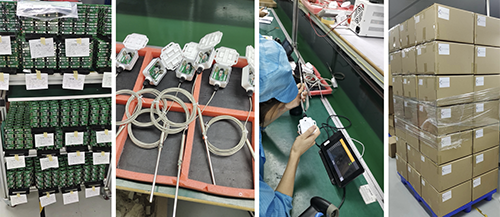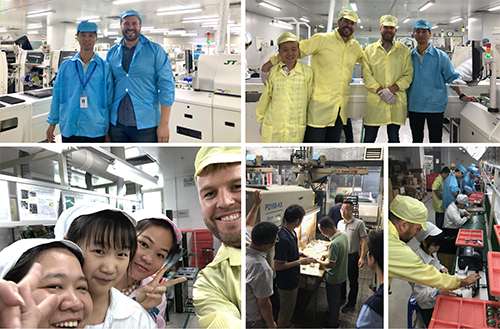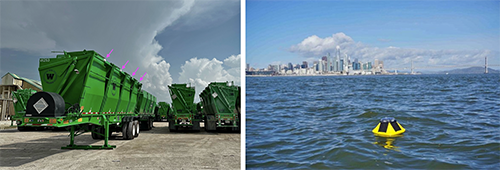The Update: Dots are back, Chinese manufacturing, and our CES showcase
This week, I’ll tell you all about making a fresh batch of 3300 Geocene Temperature Dots, what a Dot is, share the importance of (and give some love to) our manufacturing partners in China, announce our partnership with Blues Wireless at CES, and remind you about Tears and Beers this Thursday.
- We just made a new batch of our Geocene Temperature Dots. We struggled mightily to keep up with demand during the supply chain apocalypse of 2020-2022. After some luck and elbow grease, we unkinked the supply chain and can make Dots in large quantities again.

Thousands of Geocene Temperature Dots are being born! Left to right: bare PCBs, cases awaiting batteries and closure, functional testing of Bluetooth and temperature sensing, and a pallet of just half the Dots! Once we had all the parts, it only took our team in China about one week to make all 3300 of these. Amazing.
- As far as I can tell, Dots are the world’s best temperature data loggers. The data logger market is packed with lots of clunky junk. We designed Dots after years of frustration fighting that clunk. Dots can measure temperatures from about -200°C to 1200°C, have a 2-year battery life, and store two years of data onboard. They’re waterproof, ultra-rugged (we regularly chuck them off the roof to test them), run on easy-to-replace AAA batteries, and are paired with an easy-to-use Bluetooth iOS or Android app. There’s even a desktop web application to view, organize, and process all your data. We primarily sell these to cookstove adoption validation programs, but our customers also log temperatures of soils, ovens, refrigerators, furnaces, grills, HVAC systems, and so much more. Contact me!

In our unbiased opinion, the Geocene Dot is the world’s most excellent temperature data logger.
- Making thousands (or hundreds of thousands) of something is about having the right partners. It’s an entirely different challenge from making a few prototypes in the lab. We skimmed right past many challenges by working with a great set of Chinese manufacturing partners: ex-Foxconn engineers who left and started a company helping American startups find right-sized manufacturing in China. With their help, Geocene has gotten good at making products in the 1k–100k unit per year volumes.

Clockwise from top-right: (1) I’m wearing the biggest coat in the PCB factory (Chinese size 5XL, but still rocking Tommy Boy vibes), (2) the next day the factory staff bought Skot, Hall, and me unique yellow coats that actually fit, (3) Skot assisting and supervising the final assembly line, (4) our injection molding team working out some issues with sinks in the plastic case, and (5) Skot smiling with some of the final assembly staff that build the Dots!
- We will be featured in the Blues Wireless booth at CES this year! A special display of Geocene-built products is setup right next to the cappuccino machine, so come say “hi!” We’ve been building lots of fantastic projects with Blues lately. Two of our favorites are the Wedgworth fertilizer trailer monitor and the Sofar Ocean buoy. The Wedgworth fertilizer trailer monitor uses GPS and accelerometers to track where and when the fertilizer bins have been dumped. The Sofar Ocean buoy tracks weather, waves, and the ocean environment using GPS, accelerometers, and other excellent sensors. We built these products so quickly because Blues has made connecting our customers’ products to cellular networks much easier.

Left: a Wedgworth Killebrew-style fertilizer trailer. The trailer has four large fertilizer bins. Our monitor (little white box by the pink arrows) tracks how much fertilizer is left in each bin and where the trailer is in Florida. Right: a moored Sofar Ocean buoy. Near-shore buoys can take advantage of lower-cost cellular data instead of expensive satellite data.
